What Type Of Sand To Use For Pavers
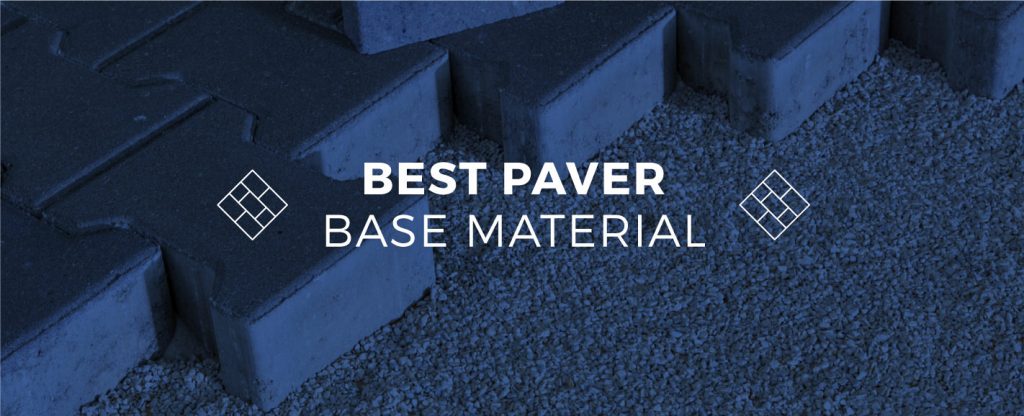
Jump-To:
- Types of Paver Base Materials
- Paver Base All-time Practices
- Find Quality Paving Materials
Concrete pavers are a versatile, bonny addition to any outdoor residential project. Their ease of installation makes for simple, efficient and timely domicile set-up with the ability to use the space immediately. To reap the total benefits of your hardscaping for years to come, it'due south essential to select and use proper paver foundation materials.
A paver base of operations encompasses several different material layers with varied support functions. The support system under pavers consists of 3 levels:
- Subgrade: The deepest level, composed of the compacted soil below the installation site
- Subbase: The heart support layer applied on top of the subgrade soil
- Base: The topmost material pavers are installed into
When selecting a base, you're choosing the materials that will anchor your pavers. Each material exhibits properties that either helps or hinders your paver arrangement. For long-lasting, resilient pavers, consider the different types of paver bases to make the best decision for your budget and project.
Types of Paver Base of operations Materials
Your base will determine whether your pavers remain smooth and level or abound uneven with time. Qualities of a suitable base material include:
- Assart of proper water drainage
- The durability to support the weight and strength the pavers volition endure
- The advisable thickness for your subgrade material
Contractors and DIY homeowners employ a variety of materials underneath pavers. Here are some things to know well-nigh the most common paver bases and their properties.
ane. Sand
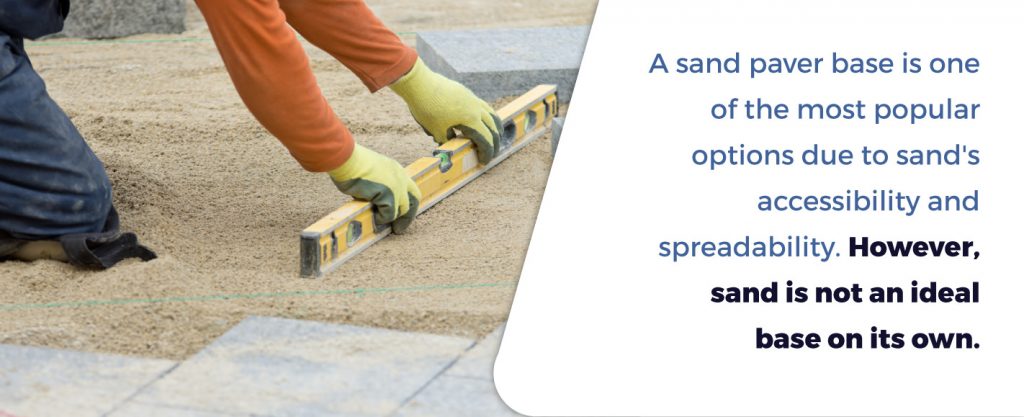
A sand paver base is one of the most popular options due to sand's accessibility and spreadability. Still, sand is not an ideal base on its own. Over time, sand shifts and tin can create an uneven foundation. If your foundation is anything just level, your pavers will show it.
Sand is oftentimes used in conjunction with crushed rock for increased durability. Because sand comes in many degrees of fineness and coarseness, not all types are suited for use every bit a paver base. The Interlocking Concrete Pavement Institute recommends done concrete sand every bit the best base sand for pavers.
Physical sand, also known as bedding sand, is coarse and doesn't trap excess moisture below the paver surface. This allows pavers to bleed after a heavy rain and maintain their structural integrity over fourth dimension.
2. Crushed Rock
A crushed stone paver base is made of pocket-size stone pieces that have been broken and screened for uniformity. According to the Minerals Pedagogy Coalition, common rock types processed into crushed rock include limestone, dolomite, granite and trap rock. Rock aggregate comes in a diversity of sizes, but nigh experts recommend 3/4-inch gravel for paver bases.
Crushed stone makes a solid paver base of operations because information technology allows water drainage and is easy to piece of work with. Similar sand, crushed stone comes in several varieties. The best amass for paver bases is a quarry processed dense form aggregate. Quarry processing creates a combination of 3/4-inch crushed stone and rock dust. This mixture binds well and increases durability, making it ane of the best materials for maximum strength and cohesion.
3. Recycled Concrete Aggregate
Recycled physical aggregate (RCA) is a crushed stone alternative with environmental benefits. Crushed stone is mined as "virgin aggregate" before it is broken into pieces and sold. RCA is made past breaking downward existing physical into gravel. The RCA process has a smaller carbon output and takes less energy than mining virgin aggregate, making it a sustainable option.
Though RCA functions similarly to crushed stone in a paver base of operations, it is impossible to know the different stone mixtures it contains. This unpredictability may make RCA a less reliable base choice when compared to crushed rock. If you're interested in an RCA paver base, talk to your provider virtually the quality of their materials to ensure your project runs as smoothly as possible.
4. Stone Dust
Stone dust is a powdery mixture of finely ground stones that has a sand-like texture. Though it can be a helpful base ingredient when mixed with other materials, about professionals recommend that you never utilize stone dust on its own as a base.
Stone grit and finely basis stone called "screenings" fall into a material category that has excessive amounts of dust particles chosen fines. The fines trap big quantities of water that prevent the base layer from fairly draining. Co-ordinate to the Interlocking Concrete Pavement Constitute, this water storage compromises a base's ability to bear and distribute loads. To proceed your pavers safe and forestall them from shifting, opt for a base material with a fiddling more durability.
5. Compacted Soil
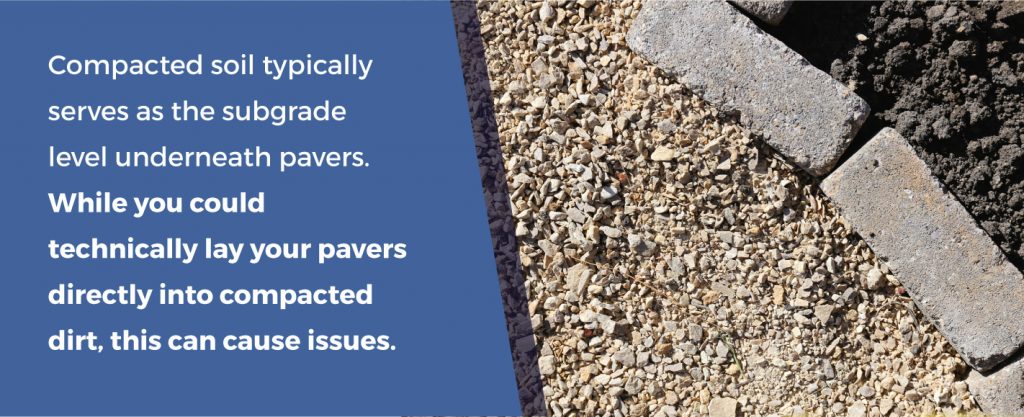
Compacted soil typically serves every bit the subgrade level underneath pavers. While you could technically lay your pavers straight into compacted dirt, this can cause problems, such as:
- Poor drainage: Compacted soil is not guaranteed to drain well. Prolonged wetness and excessive moisture could crusade instability and unevenness in your pavers.
- Initial unevenness: Depending on the location of your pavers, it may be challenging to get a completely even surface with compacted soil alone. Even slight hills and valleys will impact the pavers without a subbase or base of operations level.
- Weather warping: If the soil underneath your pavers freezes in the wintertime, the footing may sink and buckle as it thaws unevenly. Any transformation in the ground will be reflected in your pavers, creating an dangerous walkway.
For security and evenness, it's all-time to install your pavers into other materials on top of compacted soil.
Locate A Dealer
Paver Base All-time Practices
Choosing a paver base cloth is only one aspect of creating a quality base. The manner yous construct the paver base of operations ultimately impacts its effectiveness and longevity. Perhaps the most practical tip for base of operations construction is to take your time.
Laboring over three base layers before you fifty-fifty begin to lay pavers may seem like a wasteful job. But the corporeality of time and precision you put into making your base layers the correct thickness, compactness and evenness will pay off. A proper base can keep your pavers cute and functional for xx-25 years. If yous're looking for stunning results, base building is not something to be rushed.
With your commitment to detail in mind, the following are some specific base best practices to consider before y'all install your pavers.
ane. Get Started With Excavation
Paver bases require several inches of earthworks. Before you offset excavation, y'all'll want to ensure you won't hitting any underground utility equipment. Calling the number 811 volition automatically straight you lot to your state's call center and allow you to ready upward an inspection two to three days in advance.
When your utilities are marked, it's time to dig a base of operations. The purpose of this excavation is twofold. Information technology exposes surface area for the pavers to nestle into, and information technology clears loose clay from the installation site. Loose soil is unstable and can't bear as much weight equally hard, compacted earth. Removing this layer provides a potent foundation for your paver base of operations.
For added security, it's crucial to compact your subgrade soil with a vibrating plate compactor. The more compressed your subgrade soil is, the less it will shift and settle over time. This volition help keep your pavers level and in place for longer.
In add-on to removing loose soil and compacting the subgrade soil, remove whatsoever grass, roots, large rocks or other debris from the paver installation site. This gives yous an even surface to layer and build upon.
2. Dig Correct Subgrade Depth and Slope
The depth of your subgrade excavation will depend on the blazon of soil you have at the paver site. The different soil classifications include:
- Granular soil:Coarse-grained soil composed of gravel, sand or silt that crumbles easily when dry and exhibits very little cohesive strength
- Clay/cohesive soil: Fine-grained soil with high dirt content that does not crumble, is difficult to break upwardly when dry and exhibits pregnant cohesion when wet
Granular soils make strong subgrades that drain well, whereas dirt soils are weaker. For that reason, the Interlocking Concrete Pavement Establish recommends a seven-inch subgrade thickness for granular soil and a nine-inch subgrade for clay soil. Be sure to match your soil with your earthworks depth to keep your base sturdy.
In addition to depth, you'll need to incorporate a slight slope gradient in your base for water drainage. With your paver'southward location and apply in mind, determine which way the subgrade will need to slope to direct water away from the areas you'll use the almost. Your paver site should be sloped i/4-inch per pes to allow proper runoff. This volition prevent water buildup on the pavers themselves and help keep water away from your dwelling.
3. Utilise Both Sand and Crushed Rock
Equally detailed above, the best paver base is a quarry processed crushed stone subbase and a washed concrete sand base of operations. Crushed rock'southward stability paired with sand's spreadability makes a manageable, long-lasting base duo.
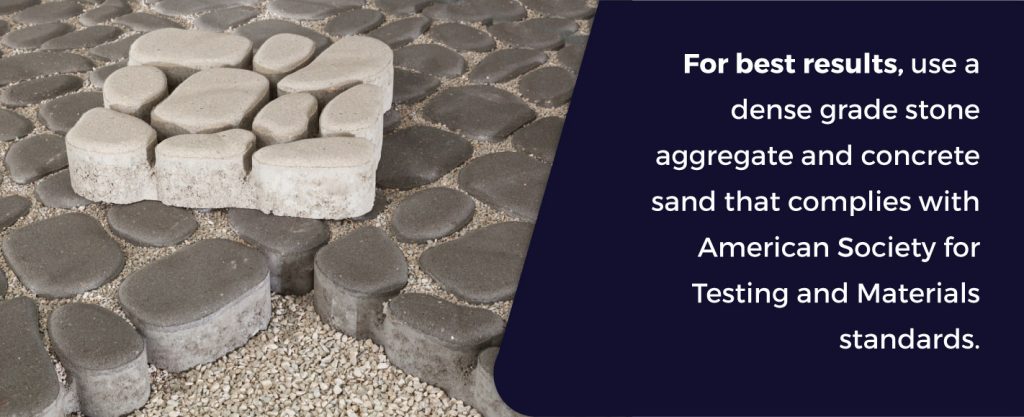
For best results, use a dense grade stone amass and physical sand that complies with American Club for Testing and Materials standards. ASTM C33 and CSA A23.1 is the recommended sand quality, merely ASTM C-144 and CSA 179 graded bricklayer's sand is likewise acceptable. Talk to your supplier to brand sure your materials marshal with these standards.
To calculate the corporeality of sand or crushed stone you should purchase, the Interlocking Concrete Pavement Institute recommends the post-obit guidelines for every 100 foursquare-pes surface area:
- 4 inches thick: ii tons of material
- Six inches thick: 3 tons of fabric
- Eight inches thick: four tons of textile
- Twelve inches thick: vi tons of material
Your material providers should exist able to assist you with your quantity calculations to ensure y'all don't run out during base structure.
iv. Compact Your Subbase in Layers
When you lot begin to build your subbase, you'll desire to besprinkle thin layers of crushed rock and so compact and slope them. Compacting increases your base'due south load-bearing abilities, while sloping maintains the proper water drainage airplane.
To meaty subbase layers, you'll need to rent a vibrating plate compactor. These machines look like minor, simplified push mowers and are typically manually operated. Their engines vibrate a base of operations plate, which can be used to compress your subbase particles closer together. Vibrating plate compactors come in a variety of sizes, so be sure to rent a motorcar that makes sense for the size of your paver project.
For maximum effectiveness, complete your compaction ane thin layer at a fourth dimension. Slightly wetting your crushed stone subbase may aid the compaction process. The more tightly-packed your subbase begins, the less likely you lot'll experience long-term settling underneath your pavers.
5. Make the Subbase Accurate and Even
Your subbase thickness will depend on the type of subgrade soil you're covering and the way your pavers volition be used. Because it's weaker, clay soil requires a thicker subbase than granular soil. It is standard to utilize a four-inch crushed stone subbase over granular soil and a half dozen-inch subbase over clay soil. These thicknesses work well for everyday pedestrian traffic.
If your pavers are located around a pool or will receive vehicle traffic, your subbase should be half dozen to viii inches thick. Extra thickness beyond 6 to eight inches may help reinforce pavers that will back up extremely heavy vehicles similar semi-trailers or campers.
To protect your pavers from unevenness, double your subbase thickness in areas that might freeze during the winter. The extra altitude between the subgrade soil and the actual pavers will help mitigate any movement due to the footing freezing and thawing.
6. Completely Fifty-fifty the Base
As yous lay your physical sand base, aim to get in less than ane.5 inches thick. Once the sand is laid, you'll need to level, or screed, it. There are many types of tools to help level the sand base. You tin use a flat, heavy 2×4 with an fastened handle to polish out the sand, or you may consider renting a dedicated screed rail for the projection. Whatever yous decide, the cease goal is to accept a completely smoothen surface for your pavers.
Gently lay the broad side of a ii×4 onto the sand and gear up a level on it to ensure your surface is every bit even as possible.
7. Install Pavers Quickly
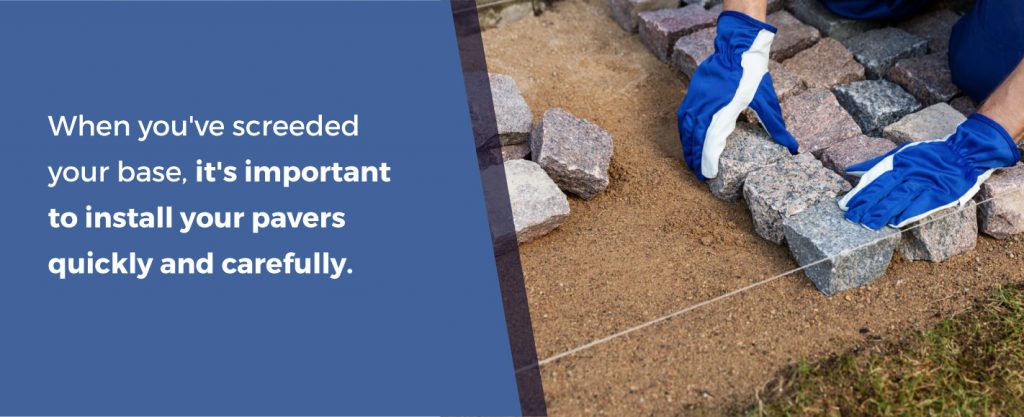
When y'all've screeded your base, it's important to install your pavers speedily and carefully. Leaving your base out overnight increases the chances that current of air, debris or people will disturb the flat surface. Your base may not be the but structure at pale if you don't work quickly. Leaving pavers out overnight can increase their moisture content, which may make them susceptible to efflorescence after installation. Efflorescence is the presence of salt deposits on your pavers, which gives them a white or greyish tint.
To avoid efflorescence and go on your base of operations level intact, begin adding pavers directly after screeding.
Discover Quality Paving Materials at Nitterhouse Masonry
Notwithstanding you lay the foundation for your project, Nitterhouse Masonry has durable pavers to match. Our paver selection covers a broad range of styles and uses, ensuring you'll find a versatile and affordable option. As a family unit-owned and operated business concern for five generations, nosotros understand longevity. Y'all can trust that our pavers will provide years of artful appeal and convenience later on installation.
To learn more about our high-quality products, call united states of america today at (717) 268-4137 or locate a dealer near you.
What Type Of Sand To Use For Pavers,
Source: https://www.nitterhousemasonry.com/blog/best-paver-base-material/
Posted by: folsehishey.blogspot.com


0 Response to "What Type Of Sand To Use For Pavers"
Post a Comment